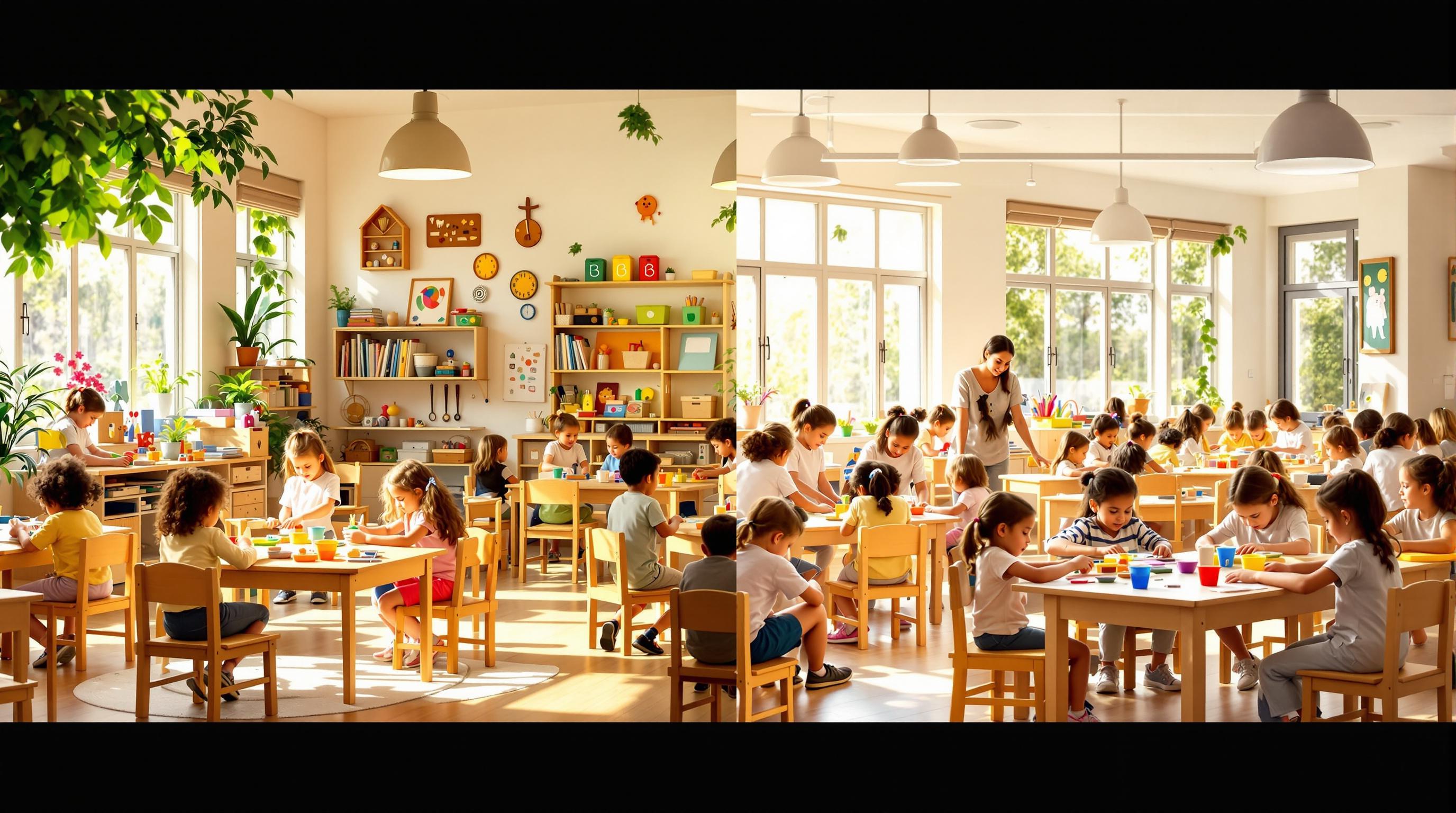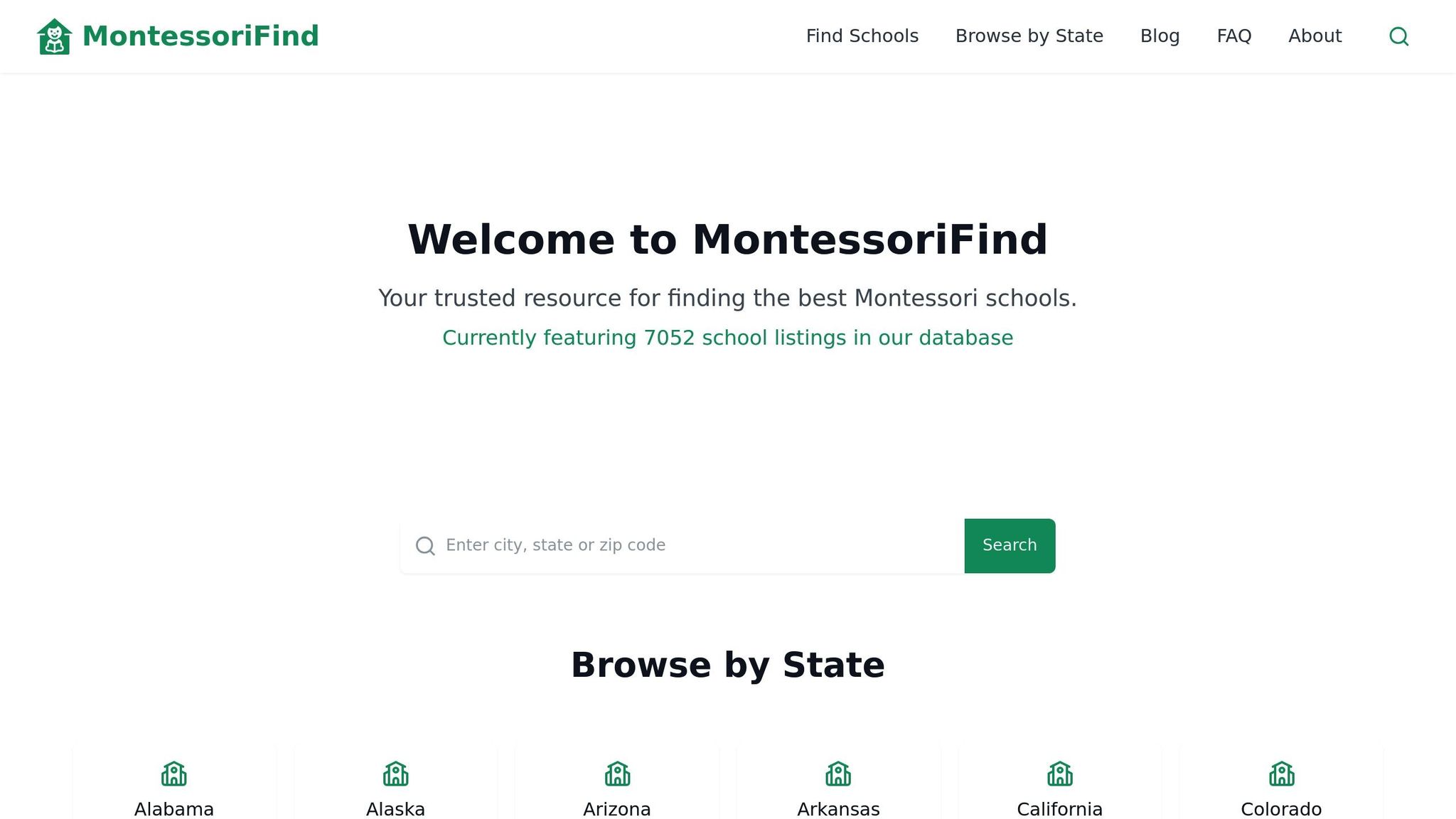Private vs Public Montessori Schools: Making the Choice

Private vs Public Montessori Schools: Making the Choice
March 10, 2025
Education Montessori School Choice
Choosing between private and public Montessori schools depends on factors like budget, curriculum, and accessibility. Here's a quick breakdown:
-
Private Montessori Schools: Typically follow Montessori principles more closely, charge tuition ($12,000–$18,000/year), and offer flexible programs with full Montessori materials.
-
Public Montessori Schools: Tuition-free but must align with state education standards. They may have fewer resources and rely on lotteries for enrollment.
Quick Comparison
| Feature | Private Montessori | Public Montessori | | --- | --- | --- | | Cost | $12,000–$18,000/year | Free (minimal fees) | | Curriculum | Strict Montessori approach | Mix of Montessori and state standards | | Enrollment | Application, interview | Open enrollment, lottery | | Teacher Requirements | Montessori certification | State license + Montessori certification | | Class Size | 28–35 students | 20–30 students | | Extra Costs | High (e.g., materials, aftercare) | Low to moderate (e.g., supplies, transportation) |
Consider your budget, location, and child’s needs to make the best choice. Keep reading for a deeper dive into the differences, costs, and what to look for during school visits.
Main Differences: Private vs Public Montessori
Money and Enrollment
The funding structure is a key difference between private and public Montessori schools, influencing both operations and accessibility.
Private Montessori schools rely on tuition fees, donations, and fundraising. This funding model allows for greater independence but comes with higher costs. In contrast, public Montessori schools are government-funded and provide tuition-free education. For example, Carson Montessori Charter School offers free education and accepts students from any county, requiring only basic documents like birth certificates and immunization records.
The enrollment process also differs: | Aspect | Private Montessori | Public Montessori | | --- | --- | --- | | Cost | Tuition-based | Free | | Admission Process | School tour, interview, and readiness assessment | Open enrollment, lottery system | | Priority System | School-specific criteria | Siblings and children of faculty prioritized | | Special Needs | May require additional documentation | Must comply with federal and non-discrimination policies |
Now, let’s explore how teaching methods vary between these schools.
Teaching Methods
Private Montessori schools typically adhere more closely to traditional Montessori principles. They offer flexibility with uninterrupted work periods, personalized learning paths, and less focus on standardized testing.
Public Montessori schools, however, must align Montessori practices with state education requirements. This means incorporating standardized testing and state-mandated curricula while still preserving key Montessori elements.
Staff Requirements
Teacher qualifications also set these schools apart.
In public Montessori schools, teachers are required to hold state teaching licenses in addition to Montessori certification. This ensures they can integrate state education standards with Montessori methods.
Private Montessori schools, on the other hand, have more leeway in their hiring practices. They prioritize Montessori-specific training and experience but don’t necessarily require state teaching licenses. Both types of schools emphasize professional growth, with public school teachers maintaining both state licenses and Montessori credentials.
Cost Breakdown
School Fees
Public Montessori schools are generally free of tuition, aside from small activity fees. Private Montessori schools, however, can be expensive. For example, Raintree Montessori School's tuition rates for 2024-25 give a clear picture of typical private school costs [3]: | Program Level | Annual Tuition | | --- | --- | | Toddler (All-day) | $16,104 | | Primary (All-day) | $13,704 | | Primary (Half-day) | $9,708 | | Elementary | $11,090 | | Erdkinder | $13,360 |
After understanding tuition, it’s important to explore financial aid options.
Payment Help Options
Private Montessori schools often provide financial assistance through these methods:
-
529 Savings Accounts: Since 2018, these accounts can be used for K-12 education, allowing families to allocate up to $10,000 annually toward private school tuition [2].
-
School-Based Aid: Some schools, like Catskill Montessori in New York, offer sliding scale tuition based on family income [5].
-
State Programs: In some states, families can access vouchers, tax credits, or education savings accounts to help cover private school costs [2].
"Don't be afraid to ask about a school's financial aid opportunities. It is one of the most common questions parents ask of private-school administrators." - The American Montessori Society [2]
Once tuition and aid are considered, it’s essential to account for additional expenses.
Extra Expenses
Both public and private Montessori schools come with extra costs. Here's a look at some common annual expenses: | Expense Category | Private Montessori | Public Montessori | | --- | --- | --- | | Registration Fee | $100 - $400 | $0 - $50 | | Materials Fee | $250 - $1,200 | $0 - $600 | | Before/After Care | $3,800 - $7,300 | $0 - $7,200 | | Transportation | $700 - $2,700 | Often included | | Lunch Program | $500 - $1,000 | $0 - $300 |
For public Montessori schools, additional yearly costs typically range from $650 to $1,500 per student [1]. Private schools may charge for extras such as:
-
Spring break camps ($200 - $600 per week)
-
Summer programs ($2,000 - $6,000 per summer)
-
Application processing fees ($25 - $100)
-
Late payment fees
These extra costs can add up, making it crucial to plan ahead when budgeting for Montessori education.
School Facilities and Materials
Learning Materials
The quality and availability of Montessori learning materials can vary significantly. Private Montessori schools often provide a full set of materials for each classroom, while public Montessori programs may need to share resources due to tighter budgets [7]. | Aspect | Private Montessori | Public Montessori | | --- | --- | --- | | Core Materials | Full sets available for every classroom | Often shared between classrooms | | Student Access | Typically provided individually | Frequently shared among students |
These differences in materials affect more than just access - they also impact classroom dynamics, including class size and staffing.
Class Size
Montessori classrooms are typically larger and include students of different ages, fostering a collaborative learning environment. The American Montessori Society (AMS) highlights this approach:
"Montessori values larger, multi-age classes that foster peer-supported learning" [6]
Here’s a comparison of typical class setups: | School Type | Student Count | Staff Composition | | --- | --- | --- | | Private Montessori | 28–35 students | 1 lead teacher + 1 assistant | | Public Montessori | 20–30 students | 1 lead teacher + 1 assistant |
For example, Washington Montessori School organizes classrooms with 20–28 students, supported by a head teacher and an associate teacher, adhering to these principles [6].
Additional Programs
Private Montessori schools often have the advantage of flexible funding, allowing them to offer a wider range of enrichment programs. These may include arts, music, outdoor education, and foreign languages. Public Montessori programs, on the other hand, may face limitations in offering such activities due to budget constraints [4].
Find the Best Montessori School for Your Child
Explore a comprehensive database of verified Montessori schools, read authentic reviews, and make informed decisions about your child's education.
How to Choose Your School
Decision Checklist
When deciding on a Montessori school, consider these important factors: | Factor | Private Schools | Public Schools | | --- | --- | --- | | Budget | Tuition fees are required | Generally free or may have minimal fees | | Location | Could mean a longer commute | Enrollment often depends on your district | | Schedule | May offer more flexible scheduling options | Follows standard public school hours | | Curriculum | Likely to stick closely to Montessori methods | May combine Montessori with traditional approaches | | Class Size | Often has larger class groups | Typically features smaller class sizes |
These points can help you weigh your options and prioritize what matters most.
School Visit Questions
When visiting a school, use these questions to guide your conversation:
-
"What percentage of the day is dedicated to Montessori methods?"
-
"Are lead teachers certified in Montessori education? If so, through which organization?"
-
"Does each classroom have a full set of Montessori materials?"
-
"How is student progress assessed while staying true to Montessori principles?"
-
"What opportunities are there for family involvement?"
These questions will give you a clearer picture of how well the school aligns with Montessori practices.
Using Montessori Find
 • Find">
• Find">
Montessori Find makes your search easier by offering:
-
Search Filters: Customize your search based on school type, location, tuition, and programs.
-
Verification System: Access verified listings with details on accreditation, teacher certification, and program specifics.
-
Parent Reviews: Read honest feedback from other parents to understand their experiences, the community dynamic, and how effectively the school implements Montessori methods.
This tool can save you time and provide valuable insights during your decision-making process.
Montessori vs Traditional Schooling: What Parents Need to Know
:::
Next Steps
Here’s how to wrap up your decision-making process between private and public Montessori schools.
Financial Planning
Start by creating a clear budget that accounts for all potential costs: | Action Item | Key Considerations | | --- | --- | | Calculate Total Costs | Factor in tuition, fees, and any extra expenses. | | Research Aid Options | Look into available financial assistance programs. | | Plan Payment Schedule | Decide on payment methods and timing. |
Schedule and Verify
-
Arrange school tours and ask for detailed program materials.
-
Use Montessori Find's database to confirm school details.
-
Check out parent reviews to get insights into the community and overall experiences.
"There's something qualitatively different about putting your school where there isn't a built-in clientele for it, and doing the work of broadcasting this as an alternative - and trying to take it to the people, literally." [8]
Documentation Review
Before making a final decision, ensure you’ve reviewed the following:
-
Teacher certification records.
-
The school’s accreditation status.
-
A detailed fee breakdown.
-
The school’s policy handbook.
Montessori Find’s verified listings can be a valuable tool for cross-referencing key details. Their database helps confirm information like teacher qualifications, special education services, and curriculum standards across schools.